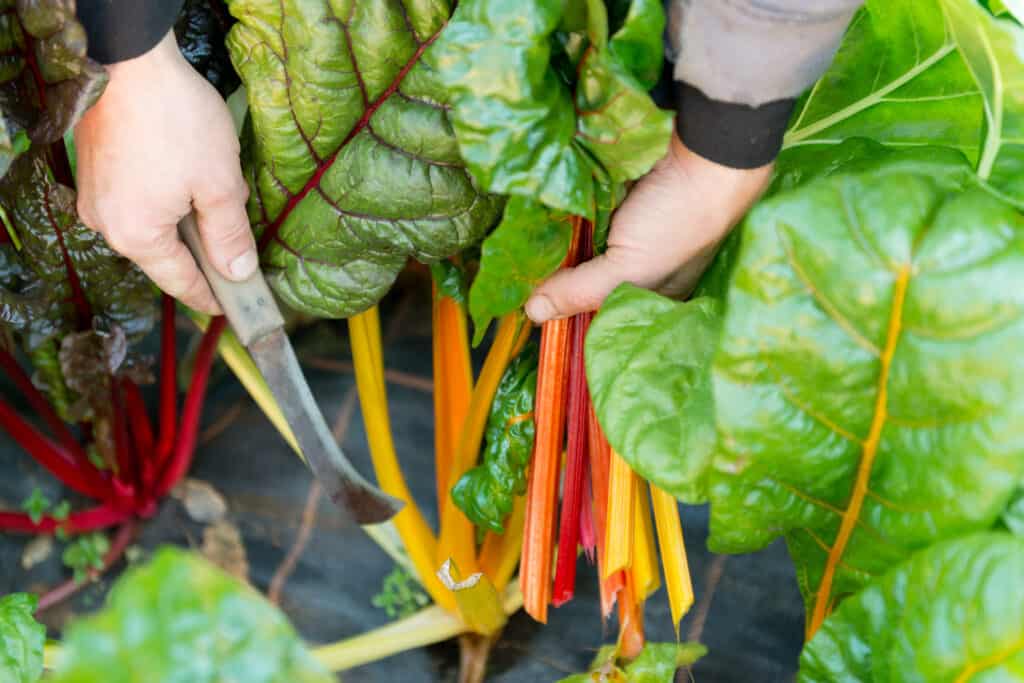Harvest Swiss chard when the leaves are tender and big enough to eat.
Swiss chard is ready for picking 30 days after sowing if you want baby leaves. Harvest chard 45 to 60 days after sowing if you want full-sized leaves with a thick midrib.
Related articles:

When to harvest Swiss Chard
- Harvest Swiss chard any time leaves are large enough to eat.
- The leaves of full-size chard can be eaten raw in salads or cooked and the midrib can be used much like celery. Baby chard has no midrib and is tender in salads.
- Grow chard for late spring and early summer harvest in cold-winter regions.
- Grow chard for autumn and winter harvest in very hot-summer regions.
- Swiss chard holds up well against warm temperatures, unlike other leafy greens. Chard will grow where summer temperatures are consistently in the 80°sF (26°+C) and, conversely, can withstand low temperatures in the 30°sF (-0°C). If chard bolts and begins to bloom in very warm weather, immediately cut off the bloom stalk and the plant will produce more leaves.
- In cold-winter regions, grow chard under a plastic tunnel or in a cold frame. In a cold frame, you can keep chard from freezing by covering plants with straw or hay. Overwintered chard will give you an early spring harvest.
Kitchen Helpers from Amazon:
- Oster Vegetable Steamer
- Chef’s Knives Set of 6
- EZ Off Jar Opener for Weak Hands
- Pepper Core Remover Stainless Steel
- Kitchen Utensils – Set of 35
- Rachel Ray Non-Stick Cookware 12pcs

How to harvest chard
- Harvest Swiss chard as close to mealtime as possible for the best flavor.
- Cut chard with garden scissors or a serrated bread knife.
- Cut chard leaf by leaf—cut the outer leaves first allowing the inner leaves to grow larger–or cut away the whole plant one inch (2.5 cm) above the soil. Either way, the plant will keep producing new leaves.
- Soil often sticks to the ruffled leaves of chard. To clean leaves fill a sink with lukewarm water and swish the leaves around then lift the leaves and set them in a colander to drain; repeat this process if the soil remains. Air dry or pat leaves dry with a cloth or paper towel before storing.
- Cut out the midrib of larger leaves before serving greens raw or cooked. Large leaves are best chopped and cooked down like spinach, or used in casseroles, soups, and pasta.

How to store chard
- Store Swiss chard cold and moist, 32°-40°F (0°-5°C) and 95 percent relative humidity. Place chard in the refrigerator in a perforated plastic bag in the vegetable crisper section. Chard will keep in the refrigerator for about 10 days.
- Chard that is stored too cold or too long will develop brown spots on the midrib and the leaves will wilt and yellow.
Swiss chard articles at Harvest to Table:
How to Plant and Grow Swiss Chard
Swiss Chard Seed Starting Tips
Growing Swiss Chard in Containers
How to Harvest and Store Swiss Chard
Five Ways to Cook and Serve Swiss Chard
Beets and Swiss Chard Growing Problems Troubleshooting
More tips:
Growing tips: How to Grow Chard.
Kitchen tips: Swiss Chard Cooking and Serving Tips
Garden Planning Books at Amazon:
- Vegetable Garden Almanac & Planner
- Kitchen Garden Grower’s Guide Vegetable Encyclopedia
- Vegetable Garden Grower’s Guide
- Tomato Grower’s Answer Book
More harvest tips:
Learn when and how to harvest your favorite vegetables for the best flavor and texture. Get storage tips for each crop. Click on the vegetable you are growing below.
- Artichoke
- Arugula
- Asparagus
- Beans
- Beets
- Broccoli
- Brussels Sprouts
- Cabbage
- Cantaloupe — Melons
- Carrots
- Cauliflower
- Celery
- Chard
- Collards
- Corn, Sweet
- Cucumbers
- Eggplant
- Endive and Escarole
- Garlic
- Jerusalem Artichoke
- Kale
- Kohlrabi
- Leeks
- Lettuce
- Melons
- Okra
- Onions
- Parsnips
- Peas
- Peppers
- Potatoes
- Pumpkins
- Radicchio
- Rhubarb
- Rutabaga
- Spinach
- Squash, Summer
- Squash, Winter
- Sunchokes
- Sweet Potato
- Swiss Chard
- Tomatillo
- Tomatoes
- Turnips
- Watermelon















